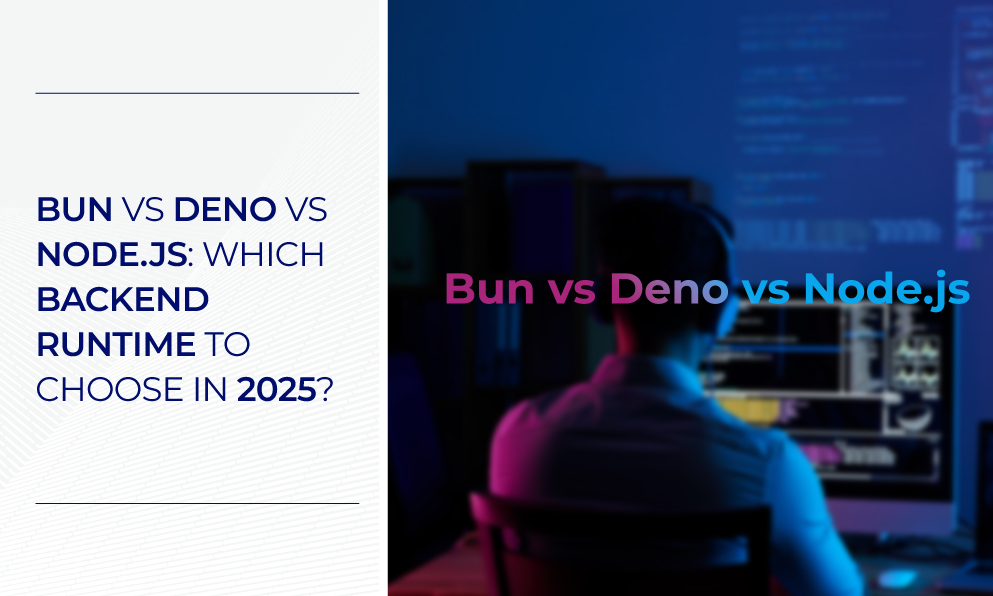In today’s fast-evolving software development landscape, backend runtimes play a foundational role in the performance, security, and scalability of web applications. With JavaScript’s continued dominance as a universal language for both frontend and backend development, developers are constantly evaluating the best runtimes to build efficient and robust systems. As of 2025, three major JavaScript runtimes are in the spotlight: Node.js, Deno, and Bun. Each of these runtimes brings distinct features, benefits, and trade-offs that make them suitable for different use cases.
This blog offers an in-depth comparison of Bun, Deno, and Node.js, highlighting their architecture, performance, ecosystem, and industry adoption trends. If you’re a developer, architect, or IT decision-maker looking to modernize your tech stack, this guide will help you make a well-informed choice.
🔧 Powered by BJIT – your trusted full-stack development partner
What is Node.js?
Node.js has been a cornerstone of backend development since its release in 2009. It introduced a non-blocking, event-driven architecture that enabled developers to build fast and scalable server-side applications using JavaScript (Tilkov & Vinoski, 2010). With the rise of single-page applications and real-time data processing needs, Node.js became the go-to runtime for full-stack JavaScript applications.
Node.js has a massive ecosystem powered by NPM, the largest package registry in the world. It supports a wide range of applications, from REST APIs to real-time applications using WebSockets. However, Node.js has certain limitations:
· No native TypeScript support (requires separate transpilation).
· Security concerns due to unrestricted file system and network access.
· Uses CommonJS modules, which are slowly being phased out in favor of ES modules.
Despite these issues, Node.js remains a safe and reliable choice for enterprise-level applications and legacy system integration. BJIT continues to use Node.js in enterprise-grade solutions where stability and long-term support are top priorities.
🔍 Keyword: Node.js alternatives 2025
What is Deno?
Deno, introduced in 2018 by Ryan Dahl (creator of Node.js), was designed to overcome the shortcomings of Node.js. Deno emphasizes security, modern syntax, and better developer experience (Deno Land, 2023).
Key features of Deno include: - Native TypeScript and JavaScript support without additional tooling. - A secure-by-default execution model, requiring explicit permissions. - Support for ES modules and a built-in dependency inspector. - A standard library with no external dependencies.
Deno’s permission-based security model is particularly valuable in environments where data privacy and access control are critical. For example, serverless environments and microservices benefit from this added layer of protection. Moreover, developers can streamline workflows by avoiding build tools like Webpack or Babel.
While Deno’s adoption is growing, it is still maturing. The NPM compatibility layer introduced in recent versions is a step forward but lacks the depth and robustness of Node.js’s ecosystem. BJIT recommends Deno for startups or innovative teams building secure-by-design applications with TypeScript.
🔍 Keyword: Deno vs Node.js 2025
What is Bun?
Bun, developed by Jarred Sumner and written in Zig, is the latest addition to the JavaScript runtime ecosystem. Its primary goal is to unify server-side tooling by integrating a runtime, bundler, transpiler, and test runner in a single package (Sumner, 2024).
Why Bun is gaining adoption in enterprise environments: - Blazing fast startup times and performance (2-3x faster than Node.js). - Native support for TypeScript and JSX. - Built-in package manager that installs dependencies faster than NPM or Yarn. - Compatibility with many Node.js APIs and NPM packages.
According to benchmark tests, Bun outperforms Node.js and Deno in operations like JSON parsing, file system I/O, and HTTP server handling (Benchmarks, 2024). For performance-intensive use cases like real-time analytics, gaming backends, and financial APIs, Bun is a compelling choice.
That said, Bun is relatively young and has not undergone the same level of enterprise scrutiny as Node.js. It may lack production-hardened stability for mission-critical systems—an area where BJIT offers architectural consultation to assess feasibility before migration or adoption.
🔍 Keyword: Bun vs Node.js
JavaScript Runtime Performance Comparison
Performance remains a key factor in choosing a backend runtime. Let’s evaluate Bun, Deno, and Node.js based on startup times, concurrency, memory usage, and real-world benchmarks.
Bun has consistently shown superior cold-start performance and reduced latency in high-load environments. Deno offers better security at the cost of slightly higher overhead, while Node.js provides a balanced performance model suitable for a wide range of applications.
🔍 Keyword: JavaScript runtime performance
🔍 Keyword: Bun JS benchmark
📊 BJIT’s internal test results on Bun vs Node vs Deno (optional case study)
Bun vs Deno vs Node.js: Side-by-Side Feature Comparison
The following comparison highlights compatibility with Docker, CI/CD pipelines, and serverless platforms:
· Docker: All three support Docker containers, but Bun’s faster build and run times are a plus in CI environments.
· Serverless: Bun and Deno are gaining popularity in edge and serverless deployment scenarios due to their startup speed.
· CI/CD Integration: Node.js leads in available plugins and community integrations; Bun and Deno are catching up.
📌 How BJIT evaluates these runtimes for client projects: Based on scalability, ecosystem maturity, compliance, and cloud compatibility.
When to Use Bun, Deno, or Node.js
Choosing the best runtime often depends on your team’s expertise, scalability needs, and infrastructure goals.
· Use Node.js for mature enterprise systems and long-term support.
· Use Deno for secure apps, internal tools, and serverless microservices.
· Use Bun for lightning-fast APIs, edge apps, and development-heavy environments.
📢 BJIT’s full-stack teams can help you migrate or build from scratch.
Community & Industry Adoption in 2025
The developer community around Node.js remains the largest, making it a safe bet for hiring and support. Deno’s adoption is stronger among open-source contributors and educational platforms. Bun is quickly gaining ground in startups and innovation labs.
Cloud platforms like AWS Lambda, Vercel, and Cloudflare Workers are integrating Bun for edge deployment. This proves its growing relevance in low-latency, serverless computing environments.
🏢 BJIT’s involvement in backend innovation with global clients includes consulting on runtime migration, optimizing backend workloads, and improving performance across JavaScript ecosystems.
Conclusion
The decision between Bun, Deno, and Node.js is ultimately about aligning technical needs with business strategy. Bun is a speed-first, modern solution, while Deno offers a secure, TypeScript-native experience. Node.js continues to be a reliable choice for a wide range of production systems.
✅ Need help deciding or building? Consult with BJIT’s backend experts for guidance, migration, and implementation support.
FAQs
Q1: Is Bun ready for production in 2025?
A: Bun is production-ready for many use cases but should be tested thoroughly for enterprise-scale systems. BJIT can assist with risk analysis and performance benchmarks.
Q2: What are the challenges in migrating from Node.js to Bun or Deno?
A: Migration involves module compatibility checks, dependency rewrites, and CI/CD updates. BJIT offers migration roadmaps and transition strategies.
Q3: How can BJIT support runtime selection and optimization?
A: BJIT provides evaluation, proof-of-concept, performance tuning, and long-term support for backend systems using Bun, Deno, and Node.js.
References
Benchmarks. (2024). Bun vs Node vs Deno Performance Tests. https://bun.sh/blog/benchmarking
Deno Land. (2023). Deno Manual. https://deno.land/manual
Sumner, J. (2024). Bun: A modern JavaScript runtime. https://bun.sh
Tilkov, S., & Vinoski, S. (2010). Node.js: Using JavaScript to Build High-Performance Network Programs. IEEE Internet Computing, 14(6), 80–83. https://doi.org/10.1109/MIC.2010.145











